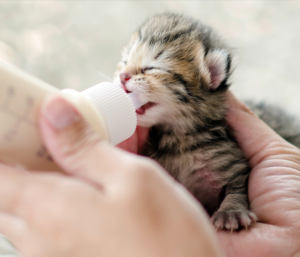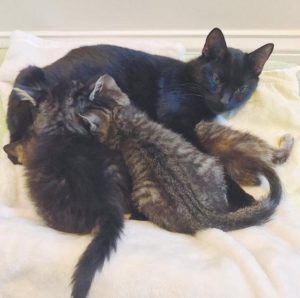Kitten Foster Care Basics
If you have the time, space, and supplies, then you’re ready to learn how to take care of your first litter! Here’s a quick and easy breakdown of the basics of kitten care:
Kittens 0-3 weeks
Get them warm and cozy. Kittens cannot regulate their body temperature, so they’re prone to hypothermia (even in the Georgia heat). Provide a heating pad on its lowest setting, but make sure there’s room for them to climb off the heating pad if they get too warm.
Once they’re nice and warm, it’s time to prepare their food. Bellow is a handy chart that shows how often and how much a kitten should eat in their first two months of life, as well as how big they should be at each weight.
Mix an appropriate amount of kitten milk replacer (KMR) for their age, place it in a kitten bottle, and heat it until it’s comfortably warm. Drop a little bit on your inner wrist, and only feed it to the kittens if it feels comfortably warm. Formula that is too hot or too cold is dangerous for fragile little babies, and they’ll probably refuse to eat it anyway.
Armed with a bottle of formula, it’s time to feed the babies. Place the kittens on their stomach in the same position they would feed from their mom. Feeding a kitten on their back will cause them to aspirate (inhale fluid), which can make them very sick. Hold their head still and place the nipple of the bottle into their mouths. They may not understand that you’re feeding them at first, so try to get a little drop into their mouth so that they taste milk. Do not try to force a kitten to eat, it will cause aspiration. Do not give up. You may choose to take a break and try again after feeding another kitten, but they need to eat at every feeding or their blood sugar will drop to dangerous levels. Do not overfeed. Too much formula in one sitting can cause diarrhea.
Now that they’re full it’s time to empty them out. Kittens do not learn to potty on their own until they’re three weeks old. Until then they need to be stimulated to pee and poop. Mom cats will do this by licking their genitals, but you can just wipe their bums with an absorbent tissue. They should pee every time you feed them, and poo about once a day. When they’re done you should wipe their mouths and bottoms with an unscented baby wipe to keep them clean and happy. You do not want to subject your kittens to bottle rot or urine scald by not cleaning them.
With their needs met, the kittens should be relaxed enough to let you weigh them. Record their weight, how much they ate, and any notes on their behavior in a notebook. By monitoring their growth at every feeding you’ll be able to catch weight loss early, which is the first sign of illness.
With that done you can finally place them back into their safe place and let them rest. Kittens under the age of three-weeks are putting all their energy to growing, so they spend all their time between feedings asleep. Try not to disturb them for anything but feedings, they’re doing important work.
Repeat this process and you’ll have happy healthy neonatal kittens.

3-4 weeks
This is a big stage in kitten development: weaning! Kittens at this age are slowly introduced to solid food, litter boxes, and play time! This is a huge step towards becoming strong independent young cats.
At this age they’re going to become more active, and require more space then just their cozy nest. This space should include a litter box with low-sides. Most kittens instinctively understand litter boxes, but if your foster needs extra help, try stimulating them to potty while they stand in the litter box. It could also help to leave some of their soiled tissues in the box so they can smell that this is their bathroom. Some kittens will play with their litter, batting it around and getting it in their mouths, so it’s important to choose a litter that will not harm them if ingested. This means no clumping litter, no clay litter, and no scented litter. The top recommended kitten litter is unscented recycled paper litter.
The first step of the weaning process is meat milk, a smooth blend of the kitten formula they know and love and a little bit of the wet kitten food you’re introducing them to. Feed this to your kittens with a bottle for a few days, and they’ll quickly get a taste for meat.
The next step is slurry, a mix of half wet food and half formula in a low-sided bowl. They will not understand how to get the food into their stomach at first, so they’ll walk in it, get it all over their face, fling it around, etc. It’s a good idea to have cleaning supplies ready. They associate your hands with feeding, so try dipping your finger in the slurry and letting them lick the mixture off. It might take them a few tries to get the hang of feeding themselves, so be sure to have a bottle ready in case they don’t get a full meal.
Once they start eating slurry like a champ, you can start giving them wet food and a bowl of water. Congratulations! You’ve weaned your foster kittens!

4-8 weeks
This is the time when kittens are learning social skills. They will wrestle with their siblings, practice hunting on their toys, and learn how to interact with humans with you, their teacher. It is crucial that you spend time interacting with them every day, teaching them how to play with you without scratching or biting, handling them regularly so that they get used to being picked up, introducing them to lots of new people so they’re not scared of strangers, and getting them ready for their futures as house cats.

Nursing moms and their kittens
When you first bring a mother cat and her kittens home you’ll want to give her space. She’s been through a lot of stress over the past few days, and now she’s in a new place with her fragile babies. She doesn’t know or trust you, so she probably will not want you interacting with her kittens much. That said, you still need to monitor the kittens and their growth every day.
Provide the mother cat with plenty of water and high quality kitten food. She’s going to need a lot of calories to produce milk for all of her babies, so her bowl should always be full.
Make sure she has access to a clean litter box and a nesting area to cuddle her babies. She might choose to settle her litter in an unexpected place, but don’t bother moving them back where you want them, she’ll just move them again.
If the mother cat is feral, try your best to socialize her. Spend quiet time with her so that she learns to relax around you. Try to hand feed her treats so she associates you with good things. If she’s not aggressive, try petting her.
At around four weeks old the mother cat will want to start weaning and you should start serving wet food.
At six weeks old the kittens should be fully weaned, and the mother cat can go back to the shelter to be spayed and find her own forever home.

Saying goodbye
One of the hardest parts of fostering is returning your fosters to the shelter. You’ll think of all the care you’ve put into this tiny life and wonder if there’s anybody else who will love them like you do. However, it’s important to remember that the kittens were never yours to begin with, and that you’ve just been babysitting them for their future families. Animal Ark works hard to place their pets with wonderful people in our community who are just waiting to give all their love and attention. By saying goodbye you are making room for the next litter of kittens, who would have been euthanized without your care.
So now you know the basics of foster kitten care. If you would like to learn more, please join us at Animal Ark Rescue on the first Thursday of every month for a foster and volunteer orientation. If you think of any questions our community of experienced fosters is always available with answers, advice, and a helping hand. Thank you for taking the time to learn how to help the little guys.

